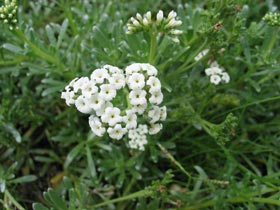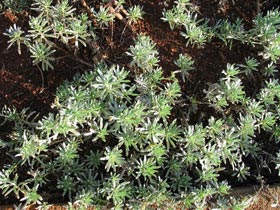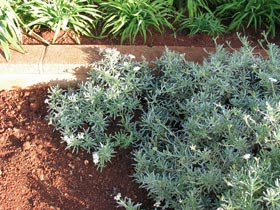Heliotropium anomalum var. argenteum
Genus
Heliotropium
Species
anomalum
Varieties
- argenteum
Hawaiian Names with Diacritics
- Hinahina
- Hinahina kū kahakai
- Nohonohopuʻuone
- Pōhinahina
Hawaiian Names
- Hinahina
- Hinahina ku kahakai
- Nohonohopuuone
- Pohinahina
Distribution Status
Endemic
Endangered Species Status
No Status
Plant Form / Growth Habit
- Shrub
Mature Size, Height (in feet)
- Shrub, Dwarf, Less than 2
Mature Size, Width
Hinahina has a mature width ranging from 2 to 5 feet.
Life Span
Long lived (Greater than 5 years)
Landscape Uses
- Accent
- Container
- Ground Cover
Additional Landscape Use Information
A beautiful ground cover when planted in black cinder and rocks which will show off the silvery foliage. Use in xeric and coastal landscapes. Hinahina will generally suppress weed growth once established.
These plants do well in pots with regular waterings. [3]
Companion Plants:
ʻIlima, maʻo, naupaka kahakai, nehe, pōhinahina, ʻākia and hala.
Source of Fragrance
- Flowers
Additional Fragrance Information
Hinahina flowers have a light to strongly sweet fragrance.
Plant Produces Flowers
Yes
Flower Type
Showy
Flower Colors
- Light Purple
- White
Additional Flower Color Information
The sweetly fragrant flowers range in color from white to pale purple.
Blooming Period
- Year Round
- Sporadic
Plant texture
- Fine
Leaf Colors
- Gray / Silverish
- Light Green
Additional Leaf Color Information
Natural populations of hinanina vary in leaf color and habit from one location to another. Some are silvery gray tightly whorled fuzzy plants; others have leaves that are loosely whorled and light green, almost succulent with little pubescence on the leaves.
Additional Pest & Disease Information
Hinahina kū hakai is prone to mealybugs, thrips, nematodes and aphids.
Fungal rot is due to overwatering and plants die back back as a result. Use well drained soil with copious amounts of crushed coral, sand and/or cinder, especially if growing the plant in pots. [9]
Fertilizer
Foliar feeding in early morning with a water-soluble or an organic fertilizer (e.g. kelp or fish emulsion) at one third to one fourth the recommended strength monthly has proved beneficial. [David Eickhoff, Native Plants Hawaiʻi]
An occasional soil drench of sea (salt) water seems to benefit these plants, perhaps due to nutrient deficiency in chemical fertilizers. Drenching is best reserved for potted plants or for planting areas dedicated for salt tolerant plants, keeping in mind the surrounding plants that may not be salt tolerant. Note too that once salts are in the soil it can very difficult, if not impossible, to leach them out. [9,10]
Pruning Information
Prune back the stragglers to encourage new growth and maintain desired shape. Do not severely prune or it can kill the plant. A maximum of 1/3 of the stems can be pruned at a time. Look for new growth before pruning again.
Water Requirements
- Dry
Additional Water Information
Allow hinahina to dry between waterings. Water only enough to keep plant from wilting.
Soil must be well drained
Yes
Light Conditions
- Full sun
Additional Lighting Information
Hinahina need at least 6 hours of full sun everyday for optimal growth and does best in south or west facing areas.
Spacing Information
Hinahina can be spaced between 6 to 12 inches for dense plantings or up to 3 to 5 feet apart to showcase the plants.
Tolerances
- Drought
- Brackish Water
- Wind
- Salt Spray
- Heat
Soils
- Sand
- Cinder
- Coral
Limitations
Plant does not like wet environments and will become greener and more leggy if given too much water.
Special Growing Needs
Hinahina kū hakai are well-suited for coastal or lowland regions. But they will also grow in mauka areas, if adequate sunshine and drainage is provided. It is also recommended for mauka regions to amend soil with crushed coral or lime to enhance growth. [9]
Natural Range
- Niʻihau
- Kauaʻi
- Oʻahu
- Molokaʻi
- Maui
- Hawaiʻi
Natural Zones (Elevation in feet, Rainfall in inches)
- Less than 150, 0 to 50 (Dry)
Additional Habitat Information
This attractive coastal plant can be found on sandy areas in its habitat. Hinahina is locally common on Niʻihau, Kauaʻi, Oʻahu, and Molokaʻi, but seemingly rare on Maui and Hawaiʻi Island. It may have formerly occurred on Lānaʻi and Kahoʻolawe.
![]() Special Features and Information
Special Features and Information
General Information
Hinahina kū hakai, or hinahina, belong to the Borage family or Boraginaceae. Two other native members of Boraginaceae are the indigenous Kou (Cordia subcordata) and Hinahina kahakai (Nama sandwicensis), a small endemic seshore plant.
There are from 250 to 300 species of Heliotropium worldwide with two native to the Hawaiian Islands, this species and kīpūkai (H. curassavicum), a coastal indigenous plant. Heliotropium anomalum var. argenteum is endemic to the main Hawaiian Islands.
Three non-native species are found in the islands as well, Blue heliotrope (Heliotropium amplexicaule), Fourspike heliotrope (H. procumbens var. depressum), and Tree heliotrope (Heliotropium foertherianum).*
_____
*syn. Tournefortia argentea
Etymology
The generic name Heliotropium is derived from the Greek helios, sun, and trope, turning, in reference to an erroneous belief that the flowers to turn to face the sun; leaves and flowers that do this are referred to as heliotropic.
The specific epithet anomalum is from the Latin anomala meaning extraordinary or abnormal.
The subspecies name argenteum means silvery.
Hawaiian Names:
Hinahina refers to gray or silverish gray in Hawaiian.
Nohonohopuʻuone is a Niʻihau name for this plant.
Early Hawaiian Use
Lei:
The fragrant white flowers and the succulent leaves were used, providing a long-lived attractive lei. [5]
Medicinal:
When the leaves of koʻokolau were not available, the leaves of hinahina kū hakai were brewed as a tea and believed to be a tonic. [2,4,8] Dried leaves were used in treatment of diabetes. [7] Too, the leaves were pounded with another plant and drunk for curing pāʻaoʻao (childhood disease, with physical weakening), ʻea (thrush), and naeʻoikū (severe asthma). [6]
Modern Use
Hinahina kū hakai was adopted in 1923 as the official flower and lei material for Kahoʻolawe, which is strange since it is not naturally found there, though it may have been in the past.
Still, it is a beautiful natural and native component of haku. Today, the readily available non-native Spanish moss (Tillandsia unsneoides), also called hinahina, is usually substituted in haku. [1]
Additional References
[1] Hawaiian Encyclopedia http://www.hawaiianencyclopedia.com/island-emblems.asp [Accessed August 6, 2008]
[2] "Native Planters in Old Hawaii--Their Life, Lore, & Environment" by E. S. Handy and Elizabeth Green Handy, page 239.
[3] "Container Gardening in Hawaii" by Janice Crowl, page 52.
[4] "Hawaiian Coastal Plants and Scenic Shorelines" by Mark David Merlin, page 7.
[5] "Nā Lei Makamae--The Treasured Lei" by Marie A. McDonald & Paul R. Weissich, page 22.
[6] "Native Hawaiian Medicine--Volume III" by The Rev. Kaluna M. Kaʻaiakamanu, page 60.
[7] "Niihau--The Traditions of an Hawaiian Island" by Rerioterai Tava, page 61.
[8] "In Gardens of Hawaii" by Marie C. Neal, page 717.
[9] "How to Plant a Native Hawaiian Garden" by Kenneth M. Nagata, page "Hinahina kūhakai."
[10] Native Plant Panel by Rick Barboza, Heidi Bornhorst, Leland Miyano and Mike DeMotta at the Landscape Industry Council of Hawaiʻi Conference & Tradeshow, 10/10/13.
PHOTOS FOR THIS SPECIES CAN BE SEEN AT THE LINK (Copy & Paste to your browser):
https://www.flickr.com/search/?user_id=50823119%40N08&sort=date-taken-desc&view_all=1&text=Heliotropium%20anomalum%20var.%20argenteum
Plant Gallery
Back to Plant List
Other Nursery Profiles for Heliotropium anomalum var. argenteum



